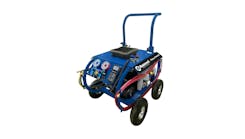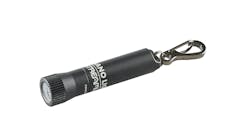This is a picture of the vehicle that had the problem with acceleration.
How many times have we looked at a vehicle’s mileage and said to ourselves that this vehicle has not been driven enough to have anything wrong with it? Then from the customer’s perspective, usually when you find a vehicle in very good condition with one owner and low mileage, it is considered a great find. But that might not always be the case, especially with a turbo diesel. While we don’t see too many diesels come into the shop other than for normal scheduled maintenance, when a low mileage one does show up for a performance concern, it usually is still under factory warranty and goes back to the dealer. However, this one ended up on my route sheet. This truck came to us after being at a different shop and even a Ford dealership in town. The customer showed several receipts of the work that had been performed, and it was a laundry list at that.
Very strange how codes for both under boost and over boost are present. How can two completely opposite faults occur from one problem? It would be similar to a rich and a lean code being set.
The problem the customer was experiencing was lack of acceleration especially when towing a load. From my experience, when towing a boat trailer with Powerstroke diesels, you don’t even realize there is something back there unless it’s the size of the Titanic. The Ford 6.0L has a lot of torque, but also has some weak areas as well.
Of course my first step was to check for codes, even though the MIL (Malfunction Indicator Lamp) was not illuminated. Sure enough, there were codes stored; P0299 Turbocharger Under Boost and P0234 Engine Over Boost Condition, Strange how these codes seem to represent two different extremes of performance. Since the complaint was lack of power, I focused on the under boost code first. This code sets when the turbo fails to reach the desired boost pressure. According to the customer, this was the same code that turned on the MIL when the other facilities diagnosed their vehicle and it seemed to fit the description of their concern. The customer also stated that an exhaust restriction code was present when at the dealership.
Someone already has installed a new converter in the vehicle either trying to fix a previous high backpressure code or the current drivability concern.
The customer had recently purchased the vehicle used and noticed the problem on their first trip towing a trailer, which is what the intended purpose of the truck was for. The vehicle appeared to be in good condition and had very low mileage for one more than 7 years old, but low mileage does not automatically mean it does not have any problems.
On my initial inspection, I did notice that vehicle had some replacement parts, but it’s what I didn’t notice that is important on a turbo diesel; no air leaks in either the intake or exhaust systems. Any time exhaust escapes the system and bypasses the turbo, boost will decrease. Inspection of the Charge Air Cooler hoses did not reveal any splits at the cooler end or more commonly found, at the turbo right where the clamp seats. A leak in the intake side also will reduce boost and cause an increase in the desired closed vane position Parameter Identifier (PID) to compensate for it.
With the KOEO, BARO, MAP and EBT all read evenly. An accurate way to check the rationality of the sensors is to verify pressure does not vary by more than 0.5 psi between any of the three.
Sometimes, with the noise of a diesel engine, leaks in the intake and exhaust systems are not as easy to pick out as they are on a quieter gasoline engine. A trick is to load the turbo either by continue to momentarily ground a wire at the VGT solenoid or commanding a high percentage with the scan tool and holding the engine at 1,200 rpm. Any leaks in the system will be much more noticeable. One of the most common leak areas on this engine, especially after any work has been performed, is at the Y-pipe on the back of the turbo. This area is also susceptible to cracking. Ford had issued Technical Service Bulletin (TSB) 05-21-9, which deals with a whistling noise from the turbocharger. A good diagnostic tip mentioned is to activate the Exhaust Gas Recirculation (EGR) valve with a scan tool to a fully open position or unplug the VGT solenoid to reduce backpressure in the exhaust system. If the whistling noise changes or disappears, then you have isolated the leak to the exhaust side of the turbo. Common failures are the EGR valve cooler to Y-pipe gasket, the turbocharger connection or cracked flexible joints on the Y-pipe assembly. With diesels, smoke can be a very good indicator of a problem; however, there was never a sign of smoke under any operating condition.
The Mode $06 Data showed that the EGR was working flawlessly, as it should since both the cooler and valve had recently been replaced. This also eliminated any concern of an exhaust restriction.
What I did find on the exhaust system inspection was a new converter. One thing to remember on vehicles that are classified as heavy duty is that they do not need to comply with the same 8-year/80,000-mile warranty light duty vehicles do. It’s possible that someone believed the truck had a plugged converter and replaced it in hopes that it would restore power. This might have been done to try to correct the high backpressure code the customer stated the vehicle previously had.
I started diagnosing the vehicle by checking some basic scan data. I compared the barometric pressure (BARO) reading, which is normally 150-151 Hz for my altitude, the Manifold Absolute Pressure (MAP) and the Exhaust Back Pressure (EBP). Take note of two things: First is very early 6.0L Powerstrokes started out using the actual sensor to measure the exhaust backpressure (2003 and some early 2004s), but there was a problem with corrosion of the backpressure sensor so a recall was issued to perform a reflash which causes the Powertrain Control Module (PCM) to ignore the EBP sensor input and calculate a value based on other sensor inputs. Those versions use MAP, BARO, Engine Oil Temperature (EOT) and MAF to calculate exhaust backpressure. The EBP sensor is still in place on the vehicle but will not be acknowledged by the PCM in actual backpressure readings. Modifications of the intake and exhaust system can affect the EBP calculated value, something to keep in mind when working on early versions that have had the recall performed.
A new EGR valve had also been recently installed to fix previous concerns.
Second, notice the MAP and EBP are the same KOEO. A defective or skewed MAP sensor can cause symptoms similar to a defective turbo. A rule of thumb is that exhaust backpressure should increase about 1 psi for each psi increase of turbo boost. Remember that the EBP PID used in the scan data had barometric pressure added to it, so it will read about 14 to 15 psi higher. A common issue is that the long tube from the exhaust manifold to the exhaust backpressure sensor gets clogged up and gives a false reading, not to mention that the exhaust backpressure sensor itself is a common failure item.
A quick test to confirm that the Exhaust Back Pressure Sensor is not sending a false signal can be done by monitoring three data PIDs before the vehicle is even started. The manufacturer states that the EBP sensor should be within 1.5 psi of the BARO voltage and MAP sensor voltage with KOEO, but some experts recommend replacing them if they are not within 0.5 psi of the other two sensors. This also checks the rationality of the other sensors as well. Problems that seem to point to a skewed MAP sensor could be caused by carbon clogging the hose port in the intake. The EBP Sensor on this vehicle checked out ok and had appeared to have been replaced during the EGR valve and cooler replacement.
The passageways in the EGR port also were clean and free of restriction, which is a common problem with this engine.
One of the biggest problems with these vehicles is that the EGR system becomes clogged. The major contributor to this is long idle periods. Other factors that contribute to the formation of carbon in the EGR system, as well as the turbocharger and exhaust backpressure sensor is excessive oil consumption, leaking injectors or low quality fuel. Remembering the information gathered from the customer during the initial interview about an exhaust restriction, I checked the Mode $06 data and found that the EGR Flow Test passed with flying colors. Also noticed in my inspection was that the EGR valve and cooler were recently replaced and this is a good thing, since cleaning them usually results in a comeback a few months down the road.
This is a capture of when the turbo actually stuck. Note how the exhaust backpressure stayed at only 13psi, even though the turbocharger vanes were commanded to their fully closed position, which should have noticeably increased backpressure.
Removing the EGR valve showed no signs of soot and carbon building up, restricting the system, which confirmed the results of the Mode $06 test. Looking at the mileage of the vehicle, either the person let the vehicle do a lot of sitting or a lot of idling. While the first is bad for the turbo, the second creates excessive carbon buildup. This might have been the cause of the replacement EGR valve and cooler assembly. On my test drive, I noticed that the truck did seem to accelerate OK with no strange noises or visible smoke in the rearview mirror. The part that made this difficult to diagnose was that the problem the customer described did not happen all of the time. When I first started driving, I didn’t really experience low power. It was near the end of the test drive route when the problem occurred. When the accelerator was used moderately, acceleration was normal, but the truck would fall flat on its face when placed under WOT for a short distance, I also noticed a slight surge when letting off the accelerator.
With the turbocharger taken apart, the damage was obvious. The play in the shaft allowed contact between the turbine blade and the housing and some debris made it pass the air filter.
While reviewing my scan tool recorded data, I found that the VGT was stuck on 85 percent, even though my foot was off the accelerator at that time. The problem seemed very erratic and would not repeat again. Noting on the scan data, the exhaust backpressure (EBP PID) remained at only 13 psi, even though the turbo vanes were commanded to the fully closed position, or at least as much as allowed, shown by the Variable Geometry Turbo Duty Cycle (VGTDC) Percentage at 85 percent. The MAP sensor reading also should have increased in response to the variable geometry turbo being commanded so high, but showed no change what so ever, further pointing to a problem with the turbo itself.
Once I jammed the accelerator pedal after decelerating, the VGTDC percentage PID starting moving again due to the movable vanes on the turbo unsticking as confirmed by the changing of the exhaust backpressure PID and the increase in pressure of the MAP PID. This led me to believe that the unison ring in the turbo was sticking or binding. This also gave me a clue as to the P0234 Engine Over Boost Condition. Something to note is that if an EGR valve is sticking or binding, this also can cause this code, but because someone already had ruled this out by replacing it, I did not put it on my list of possibilities. Lastly, what I gathered from the data was the MAP and EBP were fairly close to each other, this also moved me away from thinking there was an exhaust restriction.
A common problem that I was surprised I did not experience is a popping in the intake due to the turbocharger’s vanes sticking and then releasing as this will most definitely set the two opposite codes of the P0299 Turbocharger Under Boost and P0234 Turbocharger Over Boost. Sometimes the surge of air back through the intake is so intense that it can actually disengage the hose from the Charge Air Cooler. The hoses also can pop off for a couple of other reasons as well. There is a groove on the Charge Air Cooler that must be aligned with the notch on the hose and the hoses were intended to be installed dry. Using grease or a lubricant to help with installation may compromise the retention of the clamp.
I was certain, or at least confident enough to justify removing the turbocharger for an in-depth inspection. The job of replacing the turbo on these vehicles is not too bad. Rust is the biggest deterrent, but a can of WD-40 can make the job a whole lot easier.
There did seem to be movement in the shaft of the turbine, but the heavy rust and damage was cause for replacement.
Once I had the turbo halves separated, I found some play in the turbine shaft. As shown in the pictures, there had been enough movement to make contact between the blades and the housing and it also appears some debris got to the impeller. The other problem that stood out was the rust and carbon built up on the turbo. A good portion of the time, carbon can be cleaned off with Roloc discs trimmed down to the size of the disc holder, which are approximately 1 inch and some carb cleaner. The procedure is outlined in Ford TSB 06-23-2. However, it does state not attempt to clean rust or corrosion. What I had also expected to find was wear on the unison ring at the cam pin slot where the actuator controls the movement of the vanes. Usually the slot becomes elongated, causing the binding and sticking the customer was experiencing when driving.
After replacing the turbocharger assembly, you can see how the both the MAP and EBP respond simultaneously with the commanded position of the turbocharger vanes.
It appears that the vehicle sitting so much caused the turbo to rust up and stick. Also, if the vehicle was used for short trips, it’s possible that the turbo vanes only moved a short range of their full travel and once the vehicle required more movement, sticking occurred.
After replacing the turbocharger, I test drove the vehicle again and found the problem was gone. By looking at the scan data, the VGTDC PID is constantly moving in response to load conditions and not sticking at one position. Also note that the exhaust backpressure PID changes in response due to the moving vanes of the turbo.
Subscribe to Motor Age and receive articles like this every month…absolutely free. Click here















